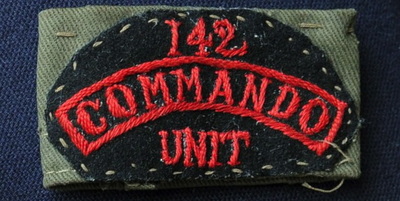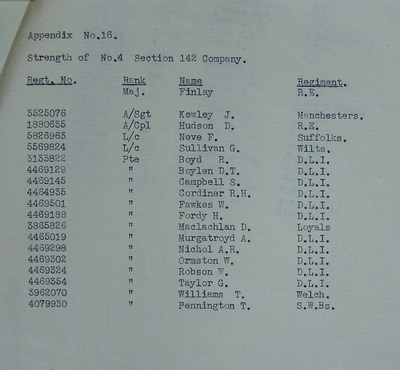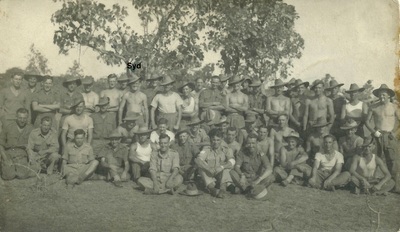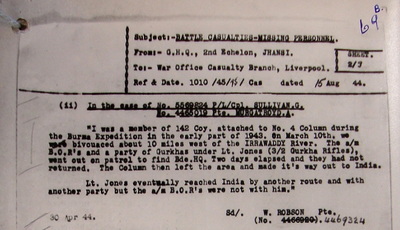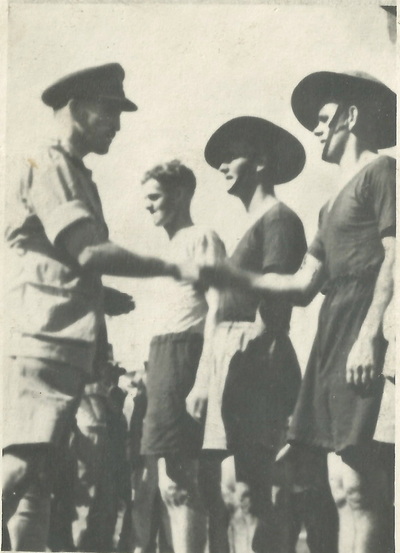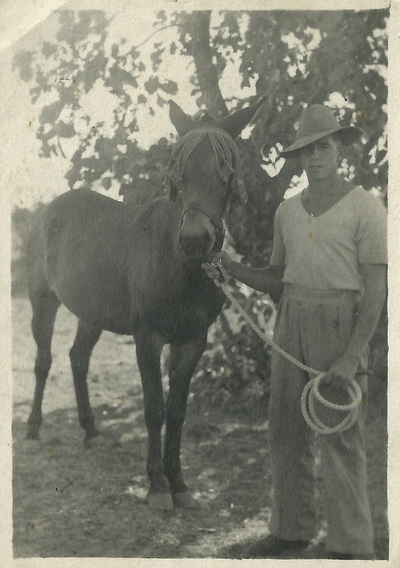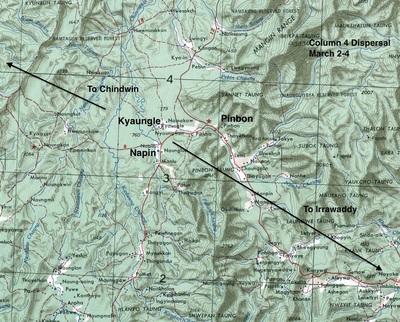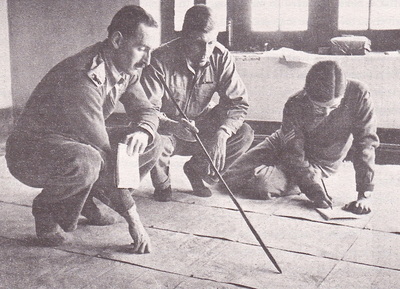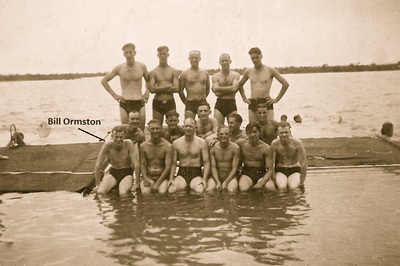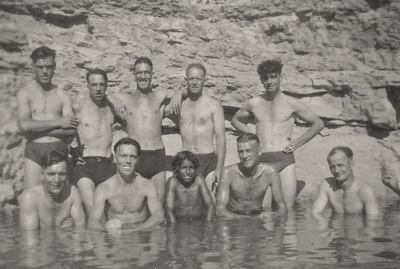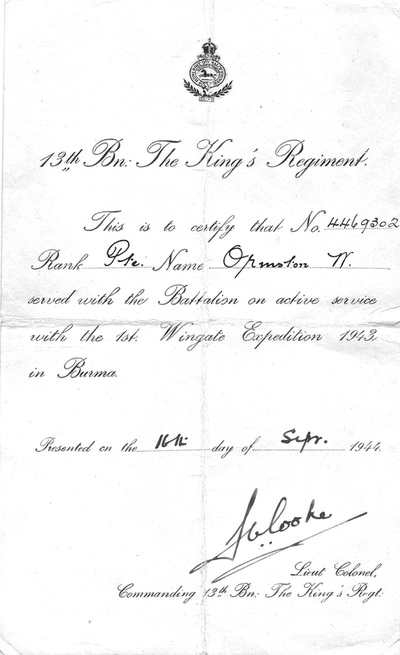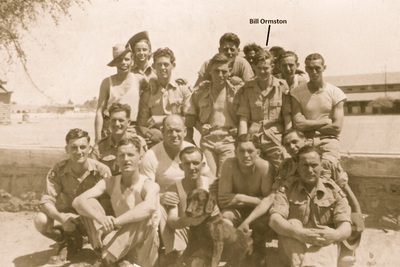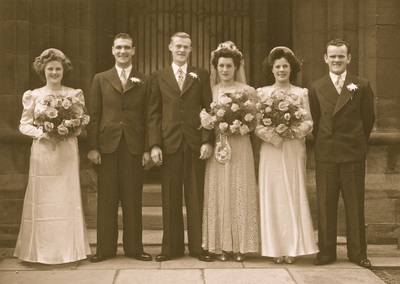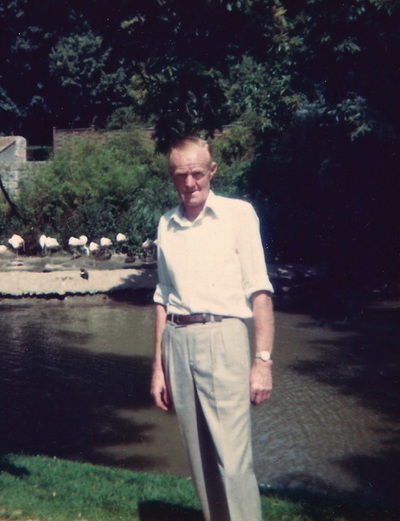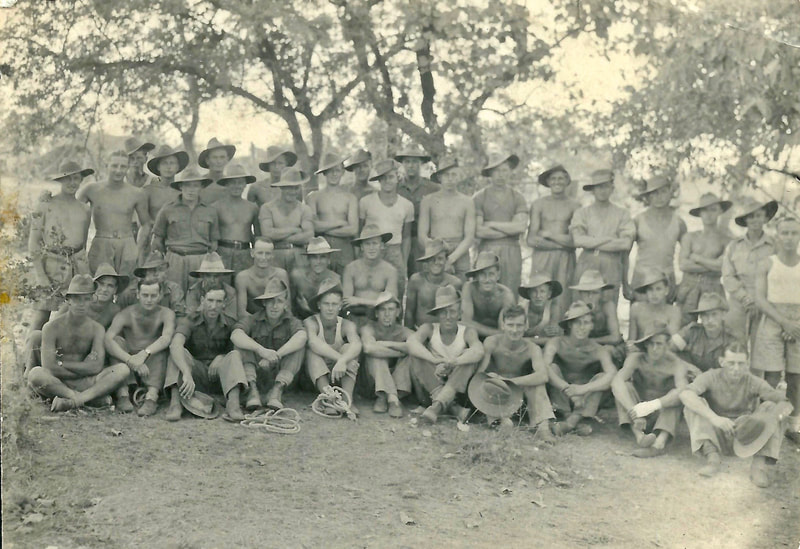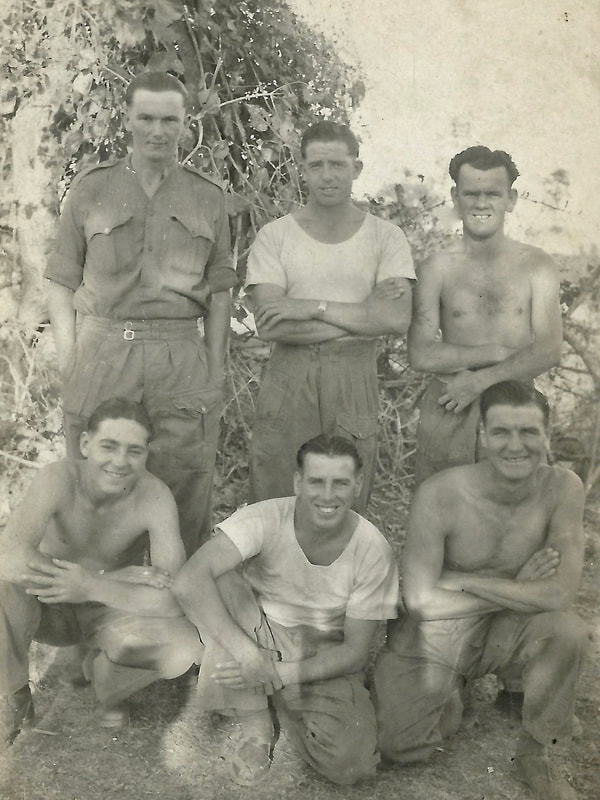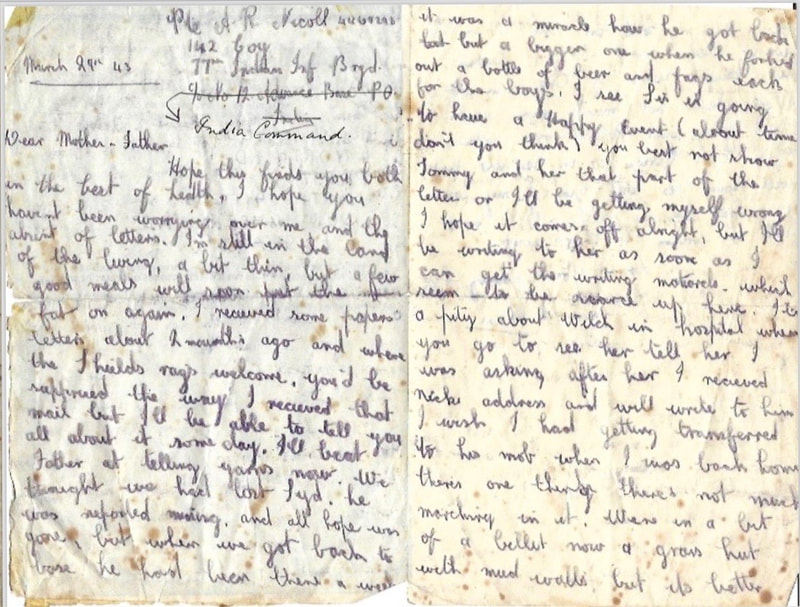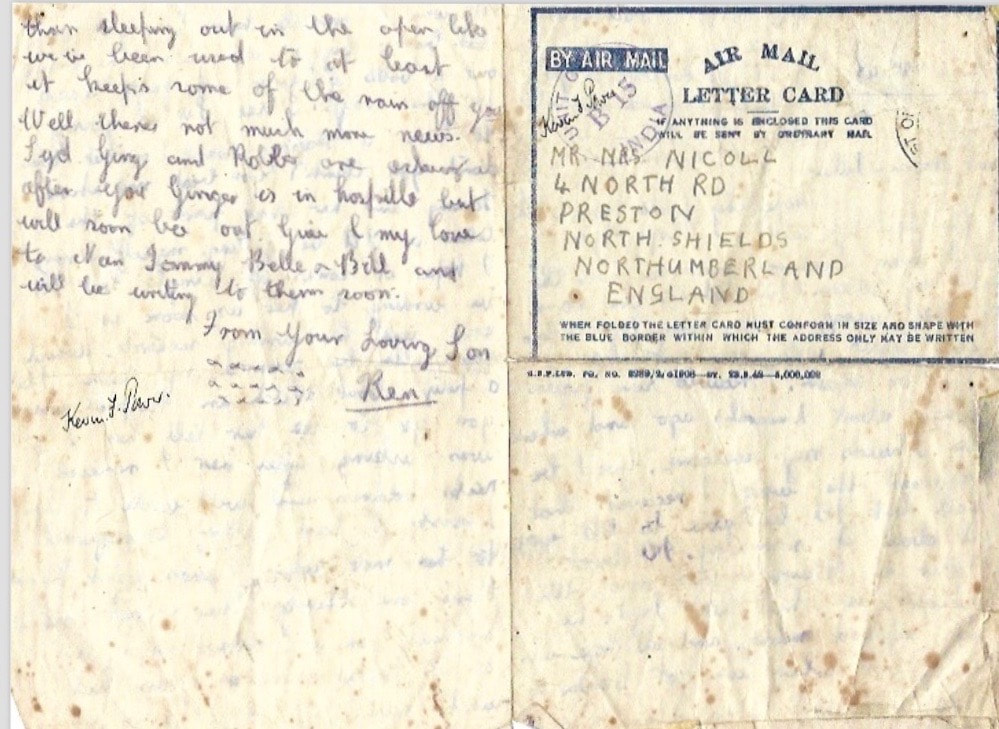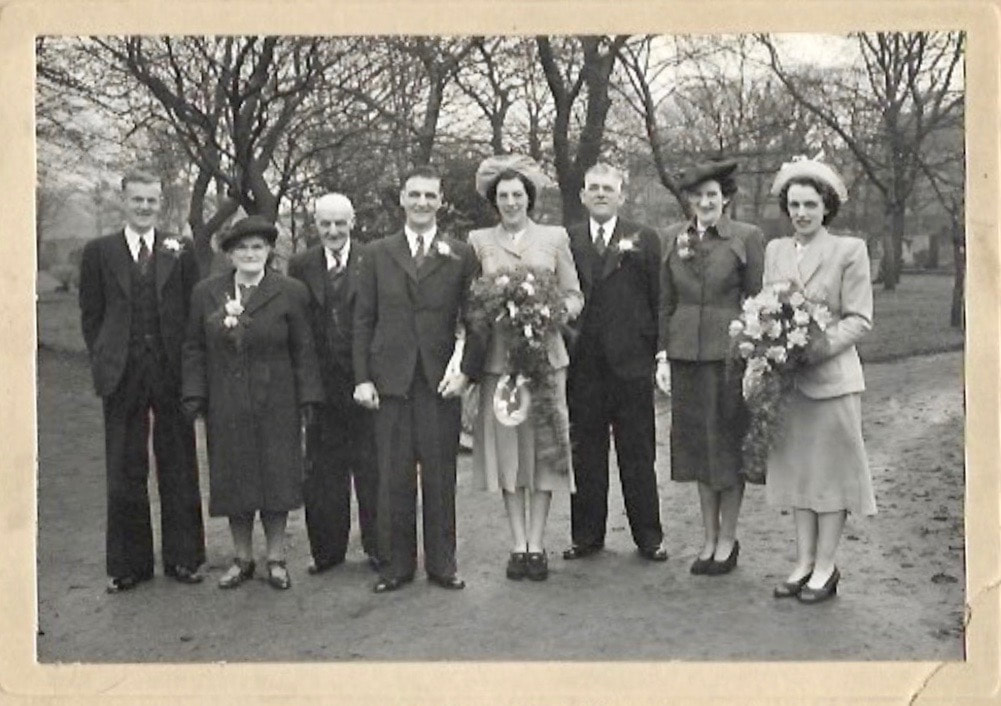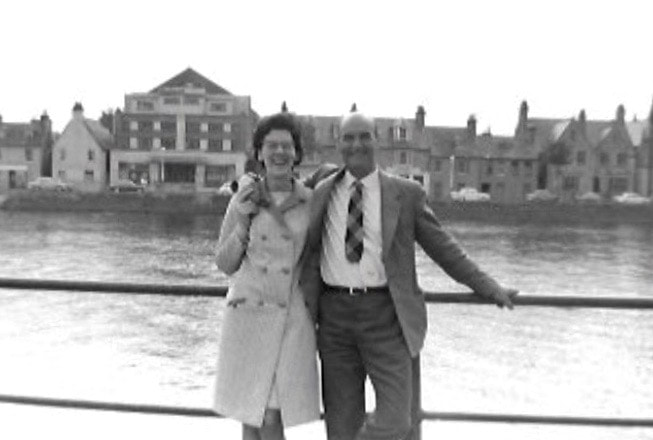The Bricklayers of Column 4 Commando
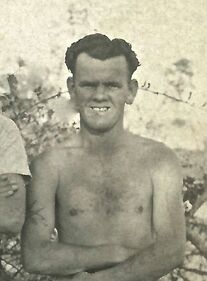 Syd Campbell, Saugor Camp 1942.
Syd Campbell, Saugor Camp 1942.
In late October 2014 I was fortunate to receive a cluster of family contacts concerning men who had taken part on Operation Longcloth by serving in one of the 142 Commando Platoons. One such contact was Syd Campbell, the son of Pte. Syd Campbell, formerly of the Durham Light Infantry and a member of Chindit Column 4 in 1943.
Syd (Junior) told me that his father was a bricklayer by trade and had been kept back from enlisting into the Armed Forces earlier in the war due to his 'reserved occupation' status as part of the building trade. Syd Campbell and his long time school friend Pte. Ren Nicholl were both from North Shields in Northumberland and were finally called-up in the middle years of the war and joined the Durham Light Infantry for their initial Army training.
Two more of their work pals also joined the DLI at that time; William 'Ginger' Ormston from Wallsend and William 'Robbo' Robson from Ferry Hill in County Durham. All these men found infantry training rather taxing and it wasn't long before they took their opportunity for more adventure by volunteering for overseas service in Special Forces.
All four men can be seen in the photograph at the top of this page. From left to right we have; Bill Ormston, Ren Nicholl, 'Robbo' Robson and Syd Campbell.
Syd (Junior) also told me that his father was a top marksman with the Lee Enfield Rifle and represented the 13th Battalion of the King's Regiment in many competitions in India. The family still posses the trophy that Syd won whilst with the 13th King's which describes him as 'Champion Shot'. They also have Syd's old Army Bible which confirms his placement in the 142 Commando Group.
The family very kindly sent me several photographs of Syd Campbell and his comrades from 142 Commando. I have to say that these are probably the best set of images I have seen in regard to the Chindits in training at the Saugor Camp. I have used some of these photographs here as part of this story, but have also placed several in the Gallery-ID-Parade pages of this website. Please follow the link below and scroll down to the relevant images.
Gallery-ID Parade
Seen below are some of the images in relation to the story of Pte. Syd Campbell, please click on any image to bring it forward on the page.
Syd (Junior) told me that his father was a bricklayer by trade and had been kept back from enlisting into the Armed Forces earlier in the war due to his 'reserved occupation' status as part of the building trade. Syd Campbell and his long time school friend Pte. Ren Nicholl were both from North Shields in Northumberland and were finally called-up in the middle years of the war and joined the Durham Light Infantry for their initial Army training.
Two more of their work pals also joined the DLI at that time; William 'Ginger' Ormston from Wallsend and William 'Robbo' Robson from Ferry Hill in County Durham. All these men found infantry training rather taxing and it wasn't long before they took their opportunity for more adventure by volunteering for overseas service in Special Forces.
All four men can be seen in the photograph at the top of this page. From left to right we have; Bill Ormston, Ren Nicholl, 'Robbo' Robson and Syd Campbell.
Syd (Junior) also told me that his father was a top marksman with the Lee Enfield Rifle and represented the 13th Battalion of the King's Regiment in many competitions in India. The family still posses the trophy that Syd won whilst with the 13th King's which describes him as 'Champion Shot'. They also have Syd's old Army Bible which confirms his placement in the 142 Commando Group.
The family very kindly sent me several photographs of Syd Campbell and his comrades from 142 Commando. I have to say that these are probably the best set of images I have seen in regard to the Chindits in training at the Saugor Camp. I have used some of these photographs here as part of this story, but have also placed several in the Gallery-ID-Parade pages of this website. Please follow the link below and scroll down to the relevant images.
Gallery-ID Parade
Seen below are some of the images in relation to the story of Pte. Syd Campbell, please click on any image to bring it forward on the page.
As already mentioned in this account, Syd Campbell and his three friends were all placed in to the Commando Platoon of Column 4. There were in fact eleven men from the Durham Light Infantry in this unit as can be seen from the personnel listing pictured above. There were at least 40 other men from the DLI that served in one Chindit unit or another in 1942-43, many of these served in the Commando Platoons from across the Brigade.
Column 4 was primarily a Gurkha unit and formed part of Northern Group in 1943, it was commanded in the first instance by Major Philip Conron. The column was the first unit from Northern Group to be attacked by the Japanese and generally had a difficult time inside Burma. Syd Campbell's Commando Platoon would have been the only unit from Column 4 made up entirely of British Army personnel, the rest of the column would have comprised of Indian and Gurkha troops.
Early on during the operation Wingate lost confidence in Major Conron and replaced him with his own Brigade-Major, George Bromhead, formerly of the Royal Berkshire Regiment and a relative of Major Gonville Bromhead VC of Rorke's Drift fame. Major Conron joined Wingate's Head Quarters and served with this unit up until his sad death close to the Shweli River on the 3rd April 1943. To read more about his time on Operation Longcloth, please click on the following link:
Dalbahadur Pun
There is very little written about the exploits of Column 4 in 1943. To help describe their time in Burma, here is an extract from the book, 'Wingate's Lost Brigade', by author Phil Chinnery:
4 Column was the first of the seven to break up and return to India. It had been led from the start by Major Conron of 3/2nd Gurkhas and had reached the Brigade rendezvous at Tonmakeng on 24 February. Thereafter it was tasked to protect a Brigade supply dropping and then to reconnoitre and improve Castens Trail, the secret track of the Zibyu Taungdan Escarpment.
It was hard work clearing the route, but necessary to avoid the Japanese. As the columns descended they saw a deep valley, in reality the head-waters of two: the Chaunggyi or Great Stream, which went northward for a few miles before turning abruptly to the west to break through the Zibyu Taungdan in a deep gorge; and the Mu Valley proper.
Across the valley rose the hills of the Mangin range, running up to 3,700 feet of the Kalat Taung opposite. Beyond the hills was the Meza Valley and beyond that, the railway and the important communications centre of Indaw. As the columns reached the valley floor, Major Fergusson noted that 'Wingate was not in the best of tempers. He was annoyed with 4 Column for some sin of omission.'
That day, 1st March, Wingate relieved Major Conron of his command and replaced him with Major Bromhead, his Brigade Major. The official reason for such a drastic step is hard to fathom. The change of command was not mentioned in Wingate's after-action report. Bromhead himself told the author: 'We were halfway across Burma when 4 Column Commander lost his nerve. He could not stand the sound of a battery charging engine and so his radios failed. Wingate withdrew him to Brigade HQ and I took his place. We managed after a day or two to get the main radio working and set off to follow Brigade HQ, who by now were way ahead.'
Conron was never able to tell his side of the story. After Wingate later ordered the dispersal of the columns he was last seen near the Shweli River in command of a group from Brigade Headquarters. According to an eyewitness account he was drowned through the treachery of Burmese boatmen while attempting to cross that river.
On 2nd March, the day after Bromhead took over command, the Burma Rifles reconnaissance detachment bumped a group of Japanese soldiers near Pinbon and one man was lost. A fighting patrol out searching for the missing man encountered another Japanese patrol and shot dead an NCO. In the meantime Wingate had decided to shift his attack on the railway from the Indaw area to the Wuntho-Bonchaung area, thirty-five miles further south.
He instructed 4 Column to rejoin the main group without delay. During the morning of 4th March, while the column was marching south-east along the base of the mountains, all hell broke loose. The column was in the usual single-file 'snake' formation and strung out over 1,000 yards when the undergrowth came alive with enemy small arms fire. Half of the formation had already crossed a small stream, when a shower of enemy mortar bombs began to fall on the ford, preventing the rest from crossing. The column had walked into a trap.
While a rearguard platoon held the enemy at the stream, Lieutenants Stuart-Jones and Green and Subedar Tikajit Pun led 135 men and thirty mules away to the north. The remainder of the column that had already crossed the stream dispersed in small groups and headed for the pre-arranged rendezvous twenty miles to the south.
Bromhead's group comprised about fifteen souls, including Captain Ray Scott of the Burma Rifles, whose knowledge of the countryside would help to get them home. However, their radios were finished. Bromhead recalled:
'We met a Jap patrol and although we beat them off our only radio got a bullet. Since the Japs used soft-nosed bullets it was the end of that radio. The column was split by the encounter, but all reached the rendezvous that evening and we sat down to consider our situation. No communications, little food and no way of getting more except courtesy of the locals, and the British Officers of the Gurkha column reported very poor morale. What to do?
'We could not influence the war, so I decided to turn back. At this point our luck changed a bit. A villager told me that at the top of a steep hill behind the village there started a forest boundary trail, going, roughly, the right way. The hill was certainly steep, but the Gurkhas with their kukris cut steps for the mules and we all reached the top. And there was a well marked trail and I could recognise the forest blazes. We managed to buy enough rice and had an uneventful march back to the Chindwin.
I mapped the route and by coincidence a battalion of my regiment (Royal Berkshires) used most of it later when Burma was invaded. On the way back my main worry was that we might be mistaken for the enemy by our own forces. Fortunately we spotted a British patrol east of the Chindwin before they saw us and made contact.
We crossed the river where a battalion of a State Force held the front. Jaipuris I think. Memorable because the Commanding Officer said, "I expect you could do with a bath", and his men dug a hole, lined it with ground sheets and filled it with hot water. The best bath I can remember.
I had written a series of non-committal "air grams" before we went into Burma and left them back at air base to be posted weekly. Thus it was that my mother got a brief letter saying that all was quite routine, at the same time as she opened her morning paper to see my ugly mug spread across the front page. 'I went back to Imphal and set up shop at the Army HQ. My tummy rebelled in a big way at the rich food and I realised that when the Brigade got back some hospital checks would be necessary.
Eventually Wingate and the columns returned but, alas, with many a gap. The Gurkhas to their own centres and the British to Bombay. Wingate and I visited Simla, the summer capital, to report. Finally he started raising the next year's force. At that moment the Army sent me to Staff College at Quetta, presumably to learn how it should be done. Next year I was in New Guinea with the Aussies.'
As for Lieutenant Stuart-Jones, his troubles were only just beginning. On the evening of the ambush he led his men north in an effort to contact the other columns. After two days he handed over command to Captain Finlay of the commando detachment and went ahead with eight others. Six days later, out of food and near collapse, they made contact with 8 Column. In the meantime Captain Finlay and his party had turned back for India, menaced by starvation. Weeks later, Stuart-Jones and his four faithful Gurkha Riflemen reached safety in Fort Hertz, a British outpost on the border with China.
Seen below is a map of the area around Pinbon where the Japanese ambushed Column 4 in early March 1943. Also shown is a rare photograph of Brigade-Major, George Bromhead, seen discussing pre-operational plans with Brigadier Orde Wingate in January 1943. Please click on each image to bring them forward on the page.
Column 4 was primarily a Gurkha unit and formed part of Northern Group in 1943, it was commanded in the first instance by Major Philip Conron. The column was the first unit from Northern Group to be attacked by the Japanese and generally had a difficult time inside Burma. Syd Campbell's Commando Platoon would have been the only unit from Column 4 made up entirely of British Army personnel, the rest of the column would have comprised of Indian and Gurkha troops.
Early on during the operation Wingate lost confidence in Major Conron and replaced him with his own Brigade-Major, George Bromhead, formerly of the Royal Berkshire Regiment and a relative of Major Gonville Bromhead VC of Rorke's Drift fame. Major Conron joined Wingate's Head Quarters and served with this unit up until his sad death close to the Shweli River on the 3rd April 1943. To read more about his time on Operation Longcloth, please click on the following link:
Dalbahadur Pun
There is very little written about the exploits of Column 4 in 1943. To help describe their time in Burma, here is an extract from the book, 'Wingate's Lost Brigade', by author Phil Chinnery:
4 Column was the first of the seven to break up and return to India. It had been led from the start by Major Conron of 3/2nd Gurkhas and had reached the Brigade rendezvous at Tonmakeng on 24 February. Thereafter it was tasked to protect a Brigade supply dropping and then to reconnoitre and improve Castens Trail, the secret track of the Zibyu Taungdan Escarpment.
It was hard work clearing the route, but necessary to avoid the Japanese. As the columns descended they saw a deep valley, in reality the head-waters of two: the Chaunggyi or Great Stream, which went northward for a few miles before turning abruptly to the west to break through the Zibyu Taungdan in a deep gorge; and the Mu Valley proper.
Across the valley rose the hills of the Mangin range, running up to 3,700 feet of the Kalat Taung opposite. Beyond the hills was the Meza Valley and beyond that, the railway and the important communications centre of Indaw. As the columns reached the valley floor, Major Fergusson noted that 'Wingate was not in the best of tempers. He was annoyed with 4 Column for some sin of omission.'
That day, 1st March, Wingate relieved Major Conron of his command and replaced him with Major Bromhead, his Brigade Major. The official reason for such a drastic step is hard to fathom. The change of command was not mentioned in Wingate's after-action report. Bromhead himself told the author: 'We were halfway across Burma when 4 Column Commander lost his nerve. He could not stand the sound of a battery charging engine and so his radios failed. Wingate withdrew him to Brigade HQ and I took his place. We managed after a day or two to get the main radio working and set off to follow Brigade HQ, who by now were way ahead.'
Conron was never able to tell his side of the story. After Wingate later ordered the dispersal of the columns he was last seen near the Shweli River in command of a group from Brigade Headquarters. According to an eyewitness account he was drowned through the treachery of Burmese boatmen while attempting to cross that river.
On 2nd March, the day after Bromhead took over command, the Burma Rifles reconnaissance detachment bumped a group of Japanese soldiers near Pinbon and one man was lost. A fighting patrol out searching for the missing man encountered another Japanese patrol and shot dead an NCO. In the meantime Wingate had decided to shift his attack on the railway from the Indaw area to the Wuntho-Bonchaung area, thirty-five miles further south.
He instructed 4 Column to rejoin the main group without delay. During the morning of 4th March, while the column was marching south-east along the base of the mountains, all hell broke loose. The column was in the usual single-file 'snake' formation and strung out over 1,000 yards when the undergrowth came alive with enemy small arms fire. Half of the formation had already crossed a small stream, when a shower of enemy mortar bombs began to fall on the ford, preventing the rest from crossing. The column had walked into a trap.
While a rearguard platoon held the enemy at the stream, Lieutenants Stuart-Jones and Green and Subedar Tikajit Pun led 135 men and thirty mules away to the north. The remainder of the column that had already crossed the stream dispersed in small groups and headed for the pre-arranged rendezvous twenty miles to the south.
Bromhead's group comprised about fifteen souls, including Captain Ray Scott of the Burma Rifles, whose knowledge of the countryside would help to get them home. However, their radios were finished. Bromhead recalled:
'We met a Jap patrol and although we beat them off our only radio got a bullet. Since the Japs used soft-nosed bullets it was the end of that radio. The column was split by the encounter, but all reached the rendezvous that evening and we sat down to consider our situation. No communications, little food and no way of getting more except courtesy of the locals, and the British Officers of the Gurkha column reported very poor morale. What to do?
'We could not influence the war, so I decided to turn back. At this point our luck changed a bit. A villager told me that at the top of a steep hill behind the village there started a forest boundary trail, going, roughly, the right way. The hill was certainly steep, but the Gurkhas with their kukris cut steps for the mules and we all reached the top. And there was a well marked trail and I could recognise the forest blazes. We managed to buy enough rice and had an uneventful march back to the Chindwin.
I mapped the route and by coincidence a battalion of my regiment (Royal Berkshires) used most of it later when Burma was invaded. On the way back my main worry was that we might be mistaken for the enemy by our own forces. Fortunately we spotted a British patrol east of the Chindwin before they saw us and made contact.
We crossed the river where a battalion of a State Force held the front. Jaipuris I think. Memorable because the Commanding Officer said, "I expect you could do with a bath", and his men dug a hole, lined it with ground sheets and filled it with hot water. The best bath I can remember.
I had written a series of non-committal "air grams" before we went into Burma and left them back at air base to be posted weekly. Thus it was that my mother got a brief letter saying that all was quite routine, at the same time as she opened her morning paper to see my ugly mug spread across the front page. 'I went back to Imphal and set up shop at the Army HQ. My tummy rebelled in a big way at the rich food and I realised that when the Brigade got back some hospital checks would be necessary.
Eventually Wingate and the columns returned but, alas, with many a gap. The Gurkhas to their own centres and the British to Bombay. Wingate and I visited Simla, the summer capital, to report. Finally he started raising the next year's force. At that moment the Army sent me to Staff College at Quetta, presumably to learn how it should be done. Next year I was in New Guinea with the Aussies.'
As for Lieutenant Stuart-Jones, his troubles were only just beginning. On the evening of the ambush he led his men north in an effort to contact the other columns. After two days he handed over command to Captain Finlay of the commando detachment and went ahead with eight others. Six days later, out of food and near collapse, they made contact with 8 Column. In the meantime Captain Finlay and his party had turned back for India, menaced by starvation. Weeks later, Stuart-Jones and his four faithful Gurkha Riflemen reached safety in Fort Hertz, a British outpost on the border with China.
Seen below is a map of the area around Pinbon where the Japanese ambushed Column 4 in early March 1943. Also shown is a rare photograph of Brigade-Major, George Bromhead, seen discussing pre-operational plans with Brigadier Orde Wingate in January 1943. Please click on each image to bring them forward on the page.
So, it would seem that after the ambush at Pinbon, Syd Campbell and the Column 4 Commandos were still moving east with Lieutenant Stuart-Jones's group. Later on, Stuart-Jones took a small party of men and attempted to make contact with the main Brigade, he did eventually stumble across Column 8 and remained with this unit until full dispersal was called in late March 1943. The two men mentioned in the witness statement given by Pte. 'Robbo' Robson (seen earlier in this story), Alec Murgatroyd and Lance Corporal George Sullivan were both with Lieut. Stuart-Jones.
To read more about Lance Corporal George Sullivan, please follow the link below:
Recce Patrol at the Nisan Forest Rest House
The 142 Commandos under the leadership of Captain Finlay, formerly of the Royal Engineers, managed to find their way back to India, but it had been a close run thing for the men, who by this time were both famished and exhausted from their ordeals.
Wingate did write down his views on the performance of Column 4 in 1943, as part of his full debrief for the operation he had this to say about the Gurkha unit:
On the 2nd and 3rd March, No.4 Column carried out various reconnaissances in the Pinbon area occasionally colliding with the enemy and collecting one Japanese body. I had ordered the Column Commander (Bromhead) to pass Pinbon eastwards not later than the 4th if he could, as I still intended to move on to Indaw.
Hearing nothing from No.5 Column about the "Happy Valley" route and learning from No.3 that the Kaignmakan route was clear, I decided to use the latter. This directed my main force on Wuntho and not Indaw. I therefore informed No.4 Column that the plan was changed, and since his wireless set was working badly, ordered him to join me before I proceeded.
He started out to do this on the 4th, and early in the morning encountered an enemy force of unknown strength, in the neighbourhood of Nyaungwuw. There followed what can only be described as a disgraceful exhibition of panic by the Gurkha Rifles; both the Burma Rifles and the British troops remaining firm and endeavouring to obey their Commander and restore order.
The brilliant history of the Gurkha Rifles in war, and indeed the splendid performances of No.3 Column in those Operations, makes it all the more necessary to tell the truth about what occurred on 4th March, but this is not the place for a post mortem.
It is sufficient to say that after repeated attempts to rally the Column and counter attack, the Column Commander did ultimately collect the greater part of his force at his Operational Rendezvous. Here I must point out that without the use of a Rendezvous to be used on Dispersal, this Column would have broken up and few indeed would have returned.
In the panic, the cipher had been lost, and it was quite impossible for me to send a R.V. in the clear although a cryptic message was sent from which it was hoped the general line of my advance could be deduced. This message did not reach the Column Commander.
The latter, who was now without supplies or means of obtaining them, had lost much indispensable equipment, and was separated from the Brigade Group by strong enemy forces, rightly decided to march back to the Chindwin. I have no adverse comment to pass on his conduct which showed judgment and courage throughout. The faults of No.4 Column were those of others.
After reaching the safety of Allied held lines, the men from 142 Commnado were taken back to the hospital at Imphal and received excellent medical care from the nursing staff under the brilliant leadership of Matron Agnes McGeary. Syd and his pals would have enjoyed several weeks of rest and recuperation in the hill stations of Assam, before re-joining the 13th King's at their new home, the Napier Barracks in Karachi.
After the war Syd Campbell returned home to North Shields and resumed his employment as a bricklayer, he continued to work alongside his best pal, Ren Nicholl until his (Syd's) unexpected death in 1969 aged just 48.
NB. From information given by Clare Riley, the granddaughter of Ren Nicholl, we now know that Syd Campbell had become separated from his unit, most probably during the ambush at Pinbon on the 4th March 1943. Thankfully, Syd and the men with him managed to return to Allied held territory successfully, from where he eagerly awaited the arrival of the rest of the Commando Platoon.
Update 20/11/2016.
I was delighted recently (9th November 2016) to receive an email contact from Susan Addison, the daughter of Pte. William Ormston:
I am the daughter of Bill Ormston, who was one of the bricklayers of Column 4 referred to by Syd Campbell. I have found your website of great interest and have some additional photographs of the Chindits which are not shown on the site and which may be of interest to you. If you can provide me with your contact details I will forward on the relevant photos, which you might wish to add to the various galleries.
Unfortunately, I don't know a great deal about my Dad's time in the Army as he would never speak about it, other than to tell us how he survived in the jungle eating insects and anything else they could find when their rations ran out. He never mentioned the fact that he was a Commando in Burma. He must, however, have been impressed with his time in India as he did say he would like to take the family back there if he could ever afford it, but sadly this never happened.
He was born in North Shields in 1920 and attended the Jubilee School. He then became a bricklayer working alongside his friends Syd Campbell, Ren Nicholl and Robbo Robson. He enlisted into the Army in 1941 and his regiments included the Durham Light Infantry from late 1941 until July 1942, followed by a short period with the Yorks and Lancs, before joining the King's Regiment on the 30th September 1942. He remained with the King's until his demob in April 1946.
Not long after leaving the Army, he got married and moved to Wallsend with his wife, Audrey. He lived there all his life and continued on as a bricklayer throughout the whole of his working life. He was due to retire in November 1985, but sadly died in June of that year, leaving behind Mam, myself and my brother Norman.
Please do use any of the photographs for your website, they are mostly of Dad and his Chindit pals enjoying a swim, presumably in India. There is also a certificate confirming his participation on the 1st Wingate Expedition in 1943 in Burma. I would be very interested in any new information you might possess about his time with the Chindits. I have also sent you a photograph of my Mam and Dad's wedding day in September 1946, which shows both Ren Nicholl and Syd Campbell (senior). The final photo shows Dad on holiday in Jersey, this was taken in 1980 when he was 60 years old.
Many thanks, Susan.
The new photographs and information in regards to Pte. Ormston were of course of great interest to me, especially the details of his regimental postings during WW2. I have always struggled to find an arrival date at the Chindit training camp for the draft of men that came originally from the Durham Light Infantry. Seeing that Bill, and presumably Syd, Ren and Robbo were all with the Yorks and Lancs prior to joining the 13th King's at Saugor, has perhaps given me the answer to this mystery.
Simply for interests sake, here is a transcription from the 13th King's War diary dated the 30th September 1942, the day Bill Ormston was posted to the 77th Indian Infantry Brigade at Saugor:
Another draft of 208 men, mostly from the Royal Welch Fusiliers, the Lancashire Fusiliers and the Loyals has arrived and the Battalion strength is now over 1000. By the time the unfit men have been posted away, we shall be very nearly up to our War Establishment number, plus these first line reinforcements. (Captain David Hastings, Adjutant).
Shown below are some of the new photographs mentioned in the above narrative. I would like to take this opportunity to thank Susan for sending me these invaluable additions to the story of the Bricklayers from No. 4 Column. Please click on any image to bring it forward on the page.
To read more about Lance Corporal George Sullivan, please follow the link below:
Recce Patrol at the Nisan Forest Rest House
The 142 Commandos under the leadership of Captain Finlay, formerly of the Royal Engineers, managed to find their way back to India, but it had been a close run thing for the men, who by this time were both famished and exhausted from their ordeals.
Wingate did write down his views on the performance of Column 4 in 1943, as part of his full debrief for the operation he had this to say about the Gurkha unit:
On the 2nd and 3rd March, No.4 Column carried out various reconnaissances in the Pinbon area occasionally colliding with the enemy and collecting one Japanese body. I had ordered the Column Commander (Bromhead) to pass Pinbon eastwards not later than the 4th if he could, as I still intended to move on to Indaw.
Hearing nothing from No.5 Column about the "Happy Valley" route and learning from No.3 that the Kaignmakan route was clear, I decided to use the latter. This directed my main force on Wuntho and not Indaw. I therefore informed No.4 Column that the plan was changed, and since his wireless set was working badly, ordered him to join me before I proceeded.
He started out to do this on the 4th, and early in the morning encountered an enemy force of unknown strength, in the neighbourhood of Nyaungwuw. There followed what can only be described as a disgraceful exhibition of panic by the Gurkha Rifles; both the Burma Rifles and the British troops remaining firm and endeavouring to obey their Commander and restore order.
The brilliant history of the Gurkha Rifles in war, and indeed the splendid performances of No.3 Column in those Operations, makes it all the more necessary to tell the truth about what occurred on 4th March, but this is not the place for a post mortem.
It is sufficient to say that after repeated attempts to rally the Column and counter attack, the Column Commander did ultimately collect the greater part of his force at his Operational Rendezvous. Here I must point out that without the use of a Rendezvous to be used on Dispersal, this Column would have broken up and few indeed would have returned.
In the panic, the cipher had been lost, and it was quite impossible for me to send a R.V. in the clear although a cryptic message was sent from which it was hoped the general line of my advance could be deduced. This message did not reach the Column Commander.
The latter, who was now without supplies or means of obtaining them, had lost much indispensable equipment, and was separated from the Brigade Group by strong enemy forces, rightly decided to march back to the Chindwin. I have no adverse comment to pass on his conduct which showed judgment and courage throughout. The faults of No.4 Column were those of others.
After reaching the safety of Allied held lines, the men from 142 Commnado were taken back to the hospital at Imphal and received excellent medical care from the nursing staff under the brilliant leadership of Matron Agnes McGeary. Syd and his pals would have enjoyed several weeks of rest and recuperation in the hill stations of Assam, before re-joining the 13th King's at their new home, the Napier Barracks in Karachi.
After the war Syd Campbell returned home to North Shields and resumed his employment as a bricklayer, he continued to work alongside his best pal, Ren Nicholl until his (Syd's) unexpected death in 1969 aged just 48.
NB. From information given by Clare Riley, the granddaughter of Ren Nicholl, we now know that Syd Campbell had become separated from his unit, most probably during the ambush at Pinbon on the 4th March 1943. Thankfully, Syd and the men with him managed to return to Allied held territory successfully, from where he eagerly awaited the arrival of the rest of the Commando Platoon.
Update 20/11/2016.
I was delighted recently (9th November 2016) to receive an email contact from Susan Addison, the daughter of Pte. William Ormston:
I am the daughter of Bill Ormston, who was one of the bricklayers of Column 4 referred to by Syd Campbell. I have found your website of great interest and have some additional photographs of the Chindits which are not shown on the site and which may be of interest to you. If you can provide me with your contact details I will forward on the relevant photos, which you might wish to add to the various galleries.
Unfortunately, I don't know a great deal about my Dad's time in the Army as he would never speak about it, other than to tell us how he survived in the jungle eating insects and anything else they could find when their rations ran out. He never mentioned the fact that he was a Commando in Burma. He must, however, have been impressed with his time in India as he did say he would like to take the family back there if he could ever afford it, but sadly this never happened.
He was born in North Shields in 1920 and attended the Jubilee School. He then became a bricklayer working alongside his friends Syd Campbell, Ren Nicholl and Robbo Robson. He enlisted into the Army in 1941 and his regiments included the Durham Light Infantry from late 1941 until July 1942, followed by a short period with the Yorks and Lancs, before joining the King's Regiment on the 30th September 1942. He remained with the King's until his demob in April 1946.
Not long after leaving the Army, he got married and moved to Wallsend with his wife, Audrey. He lived there all his life and continued on as a bricklayer throughout the whole of his working life. He was due to retire in November 1985, but sadly died in June of that year, leaving behind Mam, myself and my brother Norman.
Please do use any of the photographs for your website, they are mostly of Dad and his Chindit pals enjoying a swim, presumably in India. There is also a certificate confirming his participation on the 1st Wingate Expedition in 1943 in Burma. I would be very interested in any new information you might possess about his time with the Chindits. I have also sent you a photograph of my Mam and Dad's wedding day in September 1946, which shows both Ren Nicholl and Syd Campbell (senior). The final photo shows Dad on holiday in Jersey, this was taken in 1980 when he was 60 years old.
Many thanks, Susan.
The new photographs and information in regards to Pte. Ormston were of course of great interest to me, especially the details of his regimental postings during WW2. I have always struggled to find an arrival date at the Chindit training camp for the draft of men that came originally from the Durham Light Infantry. Seeing that Bill, and presumably Syd, Ren and Robbo were all with the Yorks and Lancs prior to joining the 13th King's at Saugor, has perhaps given me the answer to this mystery.
Simply for interests sake, here is a transcription from the 13th King's War diary dated the 30th September 1942, the day Bill Ormston was posted to the 77th Indian Infantry Brigade at Saugor:
Another draft of 208 men, mostly from the Royal Welch Fusiliers, the Lancashire Fusiliers and the Loyals has arrived and the Battalion strength is now over 1000. By the time the unfit men have been posted away, we shall be very nearly up to our War Establishment number, plus these first line reinforcements. (Captain David Hastings, Adjutant).
Shown below are some of the new photographs mentioned in the above narrative. I would like to take this opportunity to thank Susan for sending me these invaluable additions to the story of the Bricklayers from No. 4 Column. Please click on any image to bring it forward on the page.
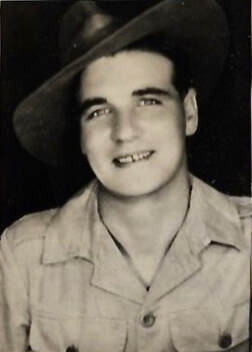 Pte. Alfred Rendell Nicoll.
Pte. Alfred Rendell Nicoll.
Update 26/11/2019.
On the 10th November 2019, the Chindit Society was pleased to receive an email enquiry from Clare Riley, in regards to the Chindit service of her grandfather, Alfred Rendell Nicoll:
My grandad was a Chindit, he served in Burma from 1942 until 1946, he and a group of friends were all bricklayers from North Shields. My Granda was Ren Nicoll and he got separated when he was part of Operation Longcloth from his best mate Syd Campbell. They did find each other again and I have a nice a letter from my Granda written in 1943 talking about their reunion.
The only reason for my contact is to see if you have any more info about his experience in Burma during the war and if not, to share the phenomenal effort he and his band of brickies made during the war. We will never forget them. I have some photographs that I can share, as well as some more personal characteristics of my Granda, for instance his long lasting love of donkeys!
Kind regards, Clare.
I was overjoyed to hear from Clare and to learn that she had already read through the information concerning her grandfather on these website pages. I am very proud now to include her heartfelt memories and thoughts about her Granda, Ren Nicholl:
It is almost impossible for me to sum up in just a few words the life of Ren Nicoll, my Granda. Before I share anything, just know that I have missed this amazing man in my life for over twenty years now and always will. Aside from my Dad, he was a true role model for me and a calming influence; he taught me how to play pool, cards, darts, how to make and crash bogeys, how to climb rocks but most of all the importance of family, friendship, honesty and hardly a day goes by when I don’t look back and think of him with a smile on my face. His real name was of course Alfred Rendell Nicoll and I am forever proud to be his granddaughter.
Syd Campbell Jnr. shared this site with me a while ago and as he still lives close to my mother, I shared some of the particulars shown here with him some time ago, including Granda's letter which we will come to later. But, for completeness, I think it is about time we added a bit more of my Granda's story, which I have to say is still a little unknown, as we do not know what part he played in Chindit operations post Longcloth, but do know from his record of service that he served in Burma with the King's Regiment until the 30th April 1946.
Pte. Ren Nicoll joined the Durham Light Infantry in December 1941, transitioning to the York & Lancs Regiment in July 1942 and the King's Regiment in September 1942. He never discussed the war. I often asked him about it as a child and teenager, but the only response I was given was one of the following:
- I ate a snake once and it tasted a bit like chicken.
- I don’t like the Japs.
- A man in the war taught me Welsh, “ar garvi matches escavenadar” it means have you any matches? This turns out not to be Welsh at all according to my best mate!
- *** he just didn’t want to ever talk about it.
The one thing I will always remember about my Granda was his love of horses and donkeys and how we used to walk over to the fields around North Shields to feed them. Of course now I know why he had such a fondness for them, but he never mentioned this to me before and I had not made the connection until I started to research his time as a Chindit.
You might by now get the idea of who Ren was a little! He was a Brickie, a quiet man with a wicked and dry sense of humour, but someone who didn’t want to share his war stories. He was a man who preferred to read Michael Palin and travel from his armchair and make the best full English breakfast you could ever wish to eat and all done by the way with one flat bone-handled knife! After he died in 1998, I decided I needed the full picture and approached my Grandma for more information. She gave me possibly the biggest prize in my possession, a letter he wrote home to his parents from India in 1943. I will always treasure this letter and transcribe it here for you now:
Dated 29th March 1943
Pte. R. Nicoll, 142 Coy, 77th Indian Infantry Brigade
Dear Mother & Father,
Hope this finds you both in the best of health, I hope you haven’t been worrying over me and the absence of letters. I am still in the land of the living, a bit thin, but a few good meals will soon put the fat on again. I received some papers and letters about 2 months ago and were the Shields Rags welcome! (local paper) You’d be surprised the way I received that mail, but I‘ll be able to tell you all about it someday. I’ll beat father at telling yarns now (my Great Granda was in Merchant Navy during WW1).
We thought we had lost Syd, he was reported missing and all hope was gone, but when we got back to base, he had been there a while, it was a miracle how he got back, but even a bigger one when he forked out a bottle of beer and fags for each of the boys.
I see Sis I going to have a happy event (about time don’t you think) you best not show Tommy and her part of this letter or I’ll be getting myself wrong. I hope it all comes off alright, but I’ll be writing to her as soon as I can get the writing materials which seem to be a bit scarce up here. It’s a pity about Wilck (?) in hospital, when you go to see her please tell her as I was asking after her. I received Nicks address and will write to him. I wish I had gotten transferred to his mob when I was back home, there’s one thing, there’s not much marching in it. We’re in a bit of a billet now, a grass hut with mud walls, but it’s better than sleeping out in the open like we’ve been used to, at least it keeps the rain off you.
Well there’s not much more news. Syd, Ging and Robbo are asking after you. Ginger is in hospital but will soon be out. Give all my love to Nan, Tommy, Belle & Bill, and will be writing to them soon.
From your loving son, Ren.
To have something from his hand during such a time will always be precious to me. I am happy for you to share the photos I've enclosed, including the one of Granda's wedding day with my Gran who served in the WAAF in Wales during the war and with William Ormston by his side on that happy day. The one courting technique we always chuckled over as a family, was when my Granda would say to my Grandma, “come sit on these brown knees and I’ll tell you a story about the war.” Marge and Ren were together almost fifty years and were the proud parents of twin girls, Isobel and Lesley Nicoll.
Steve, thank you so much for keeping all their memories alive. Kind regards, Clare (a proud granddaughter).
Clare also shared an excerpt from the poem below, that was found amongst her grandfather's belongings, perhaps it has some significance in relation to his time with the Chindits and the wonderful friends he made during his life?
On the 10th November 2019, the Chindit Society was pleased to receive an email enquiry from Clare Riley, in regards to the Chindit service of her grandfather, Alfred Rendell Nicoll:
My grandad was a Chindit, he served in Burma from 1942 until 1946, he and a group of friends were all bricklayers from North Shields. My Granda was Ren Nicoll and he got separated when he was part of Operation Longcloth from his best mate Syd Campbell. They did find each other again and I have a nice a letter from my Granda written in 1943 talking about their reunion.
The only reason for my contact is to see if you have any more info about his experience in Burma during the war and if not, to share the phenomenal effort he and his band of brickies made during the war. We will never forget them. I have some photographs that I can share, as well as some more personal characteristics of my Granda, for instance his long lasting love of donkeys!
Kind regards, Clare.
I was overjoyed to hear from Clare and to learn that she had already read through the information concerning her grandfather on these website pages. I am very proud now to include her heartfelt memories and thoughts about her Granda, Ren Nicholl:
It is almost impossible for me to sum up in just a few words the life of Ren Nicoll, my Granda. Before I share anything, just know that I have missed this amazing man in my life for over twenty years now and always will. Aside from my Dad, he was a true role model for me and a calming influence; he taught me how to play pool, cards, darts, how to make and crash bogeys, how to climb rocks but most of all the importance of family, friendship, honesty and hardly a day goes by when I don’t look back and think of him with a smile on my face. His real name was of course Alfred Rendell Nicoll and I am forever proud to be his granddaughter.
Syd Campbell Jnr. shared this site with me a while ago and as he still lives close to my mother, I shared some of the particulars shown here with him some time ago, including Granda's letter which we will come to later. But, for completeness, I think it is about time we added a bit more of my Granda's story, which I have to say is still a little unknown, as we do not know what part he played in Chindit operations post Longcloth, but do know from his record of service that he served in Burma with the King's Regiment until the 30th April 1946.
Pte. Ren Nicoll joined the Durham Light Infantry in December 1941, transitioning to the York & Lancs Regiment in July 1942 and the King's Regiment in September 1942. He never discussed the war. I often asked him about it as a child and teenager, but the only response I was given was one of the following:
- I ate a snake once and it tasted a bit like chicken.
- I don’t like the Japs.
- A man in the war taught me Welsh, “ar garvi matches escavenadar” it means have you any matches? This turns out not to be Welsh at all according to my best mate!
- *** he just didn’t want to ever talk about it.
The one thing I will always remember about my Granda was his love of horses and donkeys and how we used to walk over to the fields around North Shields to feed them. Of course now I know why he had such a fondness for them, but he never mentioned this to me before and I had not made the connection until I started to research his time as a Chindit.
You might by now get the idea of who Ren was a little! He was a Brickie, a quiet man with a wicked and dry sense of humour, but someone who didn’t want to share his war stories. He was a man who preferred to read Michael Palin and travel from his armchair and make the best full English breakfast you could ever wish to eat and all done by the way with one flat bone-handled knife! After he died in 1998, I decided I needed the full picture and approached my Grandma for more information. She gave me possibly the biggest prize in my possession, a letter he wrote home to his parents from India in 1943. I will always treasure this letter and transcribe it here for you now:
Dated 29th March 1943
Pte. R. Nicoll, 142 Coy, 77th Indian Infantry Brigade
Dear Mother & Father,
Hope this finds you both in the best of health, I hope you haven’t been worrying over me and the absence of letters. I am still in the land of the living, a bit thin, but a few good meals will soon put the fat on again. I received some papers and letters about 2 months ago and were the Shields Rags welcome! (local paper) You’d be surprised the way I received that mail, but I‘ll be able to tell you all about it someday. I’ll beat father at telling yarns now (my Great Granda was in Merchant Navy during WW1).
We thought we had lost Syd, he was reported missing and all hope was gone, but when we got back to base, he had been there a while, it was a miracle how he got back, but even a bigger one when he forked out a bottle of beer and fags for each of the boys.
I see Sis I going to have a happy event (about time don’t you think) you best not show Tommy and her part of this letter or I’ll be getting myself wrong. I hope it all comes off alright, but I’ll be writing to her as soon as I can get the writing materials which seem to be a bit scarce up here. It’s a pity about Wilck (?) in hospital, when you go to see her please tell her as I was asking after her. I received Nicks address and will write to him. I wish I had gotten transferred to his mob when I was back home, there’s one thing, there’s not much marching in it. We’re in a bit of a billet now, a grass hut with mud walls, but it’s better than sleeping out in the open like we’ve been used to, at least it keeps the rain off you.
Well there’s not much more news. Syd, Ging and Robbo are asking after you. Ginger is in hospital but will soon be out. Give all my love to Nan, Tommy, Belle & Bill, and will be writing to them soon.
From your loving son, Ren.
To have something from his hand during such a time will always be precious to me. I am happy for you to share the photos I've enclosed, including the one of Granda's wedding day with my Gran who served in the WAAF in Wales during the war and with William Ormston by his side on that happy day. The one courting technique we always chuckled over as a family, was when my Granda would say to my Grandma, “come sit on these brown knees and I’ll tell you a story about the war.” Marge and Ren were together almost fifty years and were the proud parents of twin girls, Isobel and Lesley Nicoll.
Steve, thank you so much for keeping all their memories alive. Kind regards, Clare (a proud granddaughter).
Clare also shared an excerpt from the poem below, that was found amongst her grandfather's belongings, perhaps it has some significance in relation to his time with the Chindits and the wonderful friends he made during his life?
The Making Of Friends
If nobody smiled and nobody cheered and nobody helped us along,
If each, every minute looked after himself and good things all went to the
strong;
If nobody cared just a little for you, and nobody thought about me,
And we stood all alone to the battle of life, what a dreary old world it
would be!
If there were no such a thing as a flag in the sky as a symbol of
comradeship here,
If we lived as the animals live in the woods, with nothing held sacred or
dear,
And selfishness ruled us from birth to the end, and never a neighbour had
we,
And never we gave to another in need, what a dreary old world it would be!
Oh, if we were rich as the richest on earth and strong as the strongest
that lives,
Yet never we knew the delight and the charm of the smile which the other
man gives,
If kindness were never a part of ourselves, though we owned all the land we
could see,
And friendship meant nothing at all to us here, what a dreary old world it
would be!
Life is sweet just because of the friends we have made and the things which
in common we share;
We want to live on not because of ourselves, but because of the people who
care;
It's giving and doing for somebody else, on that all life's splendour
depends,
And the joy of this world, when you've summed it all up, is found in the
making of friends.
(Edgar Albert Guest).
If nobody smiled and nobody cheered and nobody helped us along,
If each, every minute looked after himself and good things all went to the
strong;
If nobody cared just a little for you, and nobody thought about me,
And we stood all alone to the battle of life, what a dreary old world it
would be!
If there were no such a thing as a flag in the sky as a symbol of
comradeship here,
If we lived as the animals live in the woods, with nothing held sacred or
dear,
And selfishness ruled us from birth to the end, and never a neighbour had
we,
And never we gave to another in need, what a dreary old world it would be!
Oh, if we were rich as the richest on earth and strong as the strongest
that lives,
Yet never we knew the delight and the charm of the smile which the other
man gives,
If kindness were never a part of ourselves, though we owned all the land we
could see,
And friendship meant nothing at all to us here, what a dreary old world it
would be!
Life is sweet just because of the friends we have made and the things which
in common we share;
We want to live on not because of ourselves, but because of the people who
care;
It's giving and doing for somebody else, on that all life's splendour
depends,
And the joy of this world, when you've summed it all up, is found in the
making of friends.
(Edgar Albert Guest).
To complete this story, seen below is a gallery of images sent to me by Clare in relation to her Granda and his life during and after the war. These include his wedding day photograph and a copy of his letter home from India, please click on any image to bring it forward on the page.
Copyright © Steve Fogden, Syd Campbell, Sue Addison and Clare Riley. November 2014.
